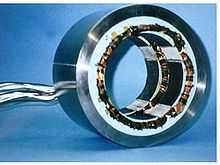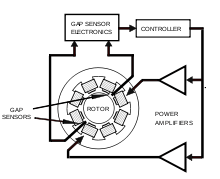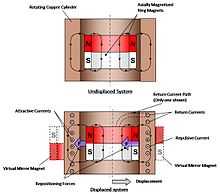Magnetic bearing

A magnetic bearing is a bearing that supports a load using magnetic levitation. Magnetic bearings support moving parts without physical contact. For instance, they are able to levitate a rotating shaft and permit relative motion with very low friction and no mechanical wear. Magnetic bearings support the highest speeds of all kinds of bearing and have no maximum relative speed.
Passive magnetic bearings use permanent magnets and, therefore, do not require any input power but are difficult to design due to the limitations described by Earnshaw's theorem. Techniques using diamagnetic materials are relatively undeveloped and strongly depend on material characteristics. As a result, most magnetic bearings are active magnetic bearings, using electromagnets which require continuous power input and an active control system to keep the load stable. In a combined design, permanent magnets are often used to carry the static load and the active magnetic bearing is used when the levitated object deviates from its optimum position. Magnetic bearings typically require a back-up bearing in the case of power or control system failure.
Magnetic bearings are used in several industrial applications such as electrical power generation, petroleum refinement, machine tool operation and natural gas handling. They are also used in the Zippe-type centrifuge,[1] for uranium enrichment and in turbomolecular pumps, where oil-lubricated bearings would be a source of contamination.
Design

An active magnetic bearing works on the principle of electromagnetic suspension and consists of an electromagnet assembly, a set of power amplifiers which supply current to the electromagnets, a controller, and gap sensors with associated electronics to provide the feedback required to control the position of the rotor within the gap. The power amplifier supplies equal bias current to two pairs of electromagnets on opposite sides of a rotor. This constant tug-of-war is mediated by the controller, which offsets the bias current by equal and opposite perturbations of current as the rotor deviates from its center position.
The gap sensors are usually inductive in nature and sense in a differential mode. The power amplifiers in a modern commercial application are solid state devices which operate in a pulse width modulation configuration. The controller is usually a microprocessor or digital signal processor.
Active bearings have several advantages: they do not suffer from wear, have low friction, and can often accommodate irregularities in the mass distribution automatically, allowing rotors to spin around their center of mass with very low vibration.
Two types of instabilities are typically present in magnetic bearings. Attractive magnets produce an unstable static force that decreases with increasing distance and increases at decreasing distances. This can cause the bearing to become unbalanced. Secondly, because magnetism is a conservative force, it provides little damping; oscillations may cause loss of successful suspension if any driving forces are present.
History
The table below lists several early patents for active magnetic bearings. Earlier patents for magnetic suspensions can be found but are excluded here because they consist of assemblies of permanent magnets of problematic stability per Earnshaw's Theorem.
| Inventor(s) | Year | Patent number | Title |
|---|---|---|---|
| Beams, Holmes | 1941 | 2,256,937 | Suspension of Rotatable Bodies |
| Beams | 1954 | 2,691,306 | Magnetically Supported Rotating Bodies |
| Beams | 1962 | 3,041,482 | Apparatus for Rotating Freely Suspended Bodies |
| Beams | 1965 | 3,196,694 | Magnetic Suspension System |
| Wolf | 1967 | 3,316,032 | Poly-Phase Magnetic Suspension Transformer |
| Lyman | 1971 | 3,565,495 | Magnetic Suspension Apparatus |
| Habermann | 1973 | 3,731,984 | Magnetic Bearing Block Device for Supporting a Vertical Shaft Adapted for Rotating at High Speed |
| Habermann, Loyen, Joli, Aubert | 1974 | 3,787,100 | Devices Including Rotating Members Supported by Magnetic Bearings |
| Habermann, Brunet | 1977 | 4,012,083 | Magnetic Bearings |
| Habermann, Brunet, LeClére | 1978 | 4,114,960 | Radial Displacement Detector Device for a Magnetic Bearings |
| Meeks, Crawford R | 1992 | 5,111,102 | Magnetic Bearing Structure |
Jesse Beams from the University of Virginia filed some of the earliest active magnetic bearing patents [2][3] during World War II. The patents dealt with ultracentrifuges intended for the enrichment of isotopes of elements needed for the Manhattan Project. However, magnetic bearings did not mature until advances in solid-state electronics and modern computer-based control technology with the work of Habermann[4] and Schweitzer.[5] In 1987, E. Croot further improved active magnetic bearing technology,[6] but these designs were not manufactured due to expensive costs of production.
Kasarda[7] reviews the history of active magnetic bearings in depth. She notes that the first commercial application of active magnetic bearings was in turbomachinery. The active magnetic bearing allowed the elimination of oil reservoirs on compressors for the NOVA Gas Transmission Ltd. (NGTL) gas pipelines in Alberta, Canada. This reduced the fire hazard allowing a substantial reduction in insurance costs. The success of these magnetic bearing installations led NGTL to pioneer the research and development of a digital magnetic bearing control system as a replacement for the analog control systems supplied by the American company Magnetic Bearings Inc. In 1992, NGTL's magnetic bearing research group formed the company Revolve Technologies Inc. for commercializing the digital magnetic bearing technology. The company was later purchased by SKF of Sweden. The French company S2M, founded in 1976, was the first to commercially market active magnetic bearings. Extensive research on magnetic bearings continues at the University of Virginia in the Rotating Machinery and Controls Industrial Research Program .
Starting from 1996 the Dutch oil and gas company NAM installed over a period of 10 years 20 large E-motor driven (with variable speed drive) gas compressors of 23 MW fully equipped with active magnetic bearings on both the E-motor and the compressor. These compressors are used in the Groningen gas field to extract the remaining gas from this large gas field and to increase the field capacity. The motor-compressor design was done by Siemens and the active magnetic bearings were delivered by Waukesha Bearings (owned by Dover Corporation). (Originally these bearings were designed by Glacier, this company was later taken over by Federal Mogul and is now part of Waukesha Bearings.) By using active magnetic bearings and a direct drive between motor and compressor (without the gearbox in between) and applying dry gas seals, a full dry-dry (oil free) system has been installed. Applying active magnetic bearings in the driver and in the compressor (compared to the traditional configuration with a gearbox, plain bearings and a gasturbine-driver) results in a relatively simple system with a very wide operating range and high efficiencies (particularly at partial load). As done in the Groningen field, the full installation can additionally be placed outdoors without the need for a large compressor building.
Meeks[8] pioneered hybrid magnetic bearing designs (US patent 5,111,102) in which permanent magnets provide the bias field and active control coils are used for stability and dynamic control. These designs using permanent magnets for bias fields are smaller and of lighter weight than purely electromagnetic bearings. The electronic control system is also smaller and requires less electrical power because the bias field is provided by the permanent magnets. One of the most successful applications of this technology was by Danfoss, a manufacturer of refrigerator turbopumps. Using permanent magnet bias magnetic bearings allows the compressors to operate at over 40,000 rpm instead of the traditional 3,600 rpm. The Danfoss compressors are an order of magnitude smaller and lighter in weight than the lower speed compressors that they replace. Thousands of compressors using this advanced magnetic bearing technology have been manufactured by Danfoss in Florida.
As the development of the necessary components progressed, scientific interest in the field also increased, peaking in the first International Symposium on Magnetic Bearings held in 1988 in Zurich with the founding of the International Society of Magnetic Bearings by Prof. Schweitzer (ETHZ), Prof. Allaire (University of Virginia), and Prof. Okada (Ibaraki University). Since then, the symposium has developed into a biennial conference series with a permanent portal on magnetic bearing technology where all symposium contributions are made available. The web portal is supported by the international research and industrial community. Joining the hall of fame and earning lifetime achievement awards in 2012 were Prof. Yohji Okada, Prof. Gerhard Schweitzer, and Michael Swann of Waukesha Magnetic Bearings .
Applications
Magnetic bearing advantages include very low and predictable friction, and the ability to run without lubrication and in a vacuum. Magnetic bearings are increasingly used in industrial machines such as compressors, turbines, pumps, motors and generators.
Magnetic bearings are commonly used in watt-hour meters by electric utilities to measure home power consumption. They are also used in high-precision instruments and to support equipment in a vacuum, for example in flywheel energy storage systems. A flywheel in a vacuum has very low wind resistance losses, but conventional bearings usually fail quickly in a vacuum due to poor lubrication. Magnetic bearings are also used to support maglev trains in order to get low noise and smooth ride by eliminating physical contact surfaces. Disadvantages include high cost, and relatively large size.
A new application of magnetic bearings is in artificial hearts. The use of magnetic suspension in ventricular assist devices was pioneered by Prof. Paul Allaire and Prof. Houston Wood at the University of Virginia, culminating in the first magnetically suspended ventricular assist centrifugal pump (VAD) in 1999.[citation needed]
Future advances

With the use of an induction-based levitation system present in maglev technologies such as the Inductrack system, magnetic bearings could replace complex control systems by using Halbach Arrays and simple closed loop coils. These systems gain in simplicity, but are less advantageous with regard to eddy current losses. For rotating systems it is possible to use homopolar magnet designs instead of multipole Halbach structures, which reduces losses considerably.
An example that has bypassed the Earnshaw's theorem issues is the homopolar electrodynamic bearing invented by Dr Torbjörn Lembke.[9][10][11] This is a novel type of electromagnetic bearing based on a passive magnetic technology. It does not require any control electronics to operate and works because the electrical currents generated by motion cause a restoring force.
See also
References
- ↑ Charles, D., Spinning a Nuclear Comeback, Science, Vol. 315, (30 March 2007)
- ↑ Beams, J. , Production and Use of High Centrifugal Fields, Science, Vol. 120, (1954)
- ↑ Beams, J. , Magnetic Bearings, Paper 810A, Automotive Engineering Conference, Detroit, Michigan, USA, SAE (Jan. 1964)
- ↑ Habermann,H. , Liard, G. Practical Magnetic Bearings , IEEE Spectrum, Vol. 16, No. 9, (September 1979)
- ↑ Schweitzer, G. , Characteristics of a Magnetic Rotor Bearing for Active Vibration Control, Paper C239/76, First International Conference on Vibrations in Rotating Machinery, (1976)
- ↑ E. Croot, Australian Inventors Weekly, NSW Inventors Association, Vol. 3, (April 1987)
- ↑ Kasarda, M. An Overview of Active Magnetic Bearing Technology and Applications, The Shock and Vibration Digest, Vol.32, No. 2: A Publication of the Shock and Vibration Information Center, Naval Research Laboratory, (March 2000)
- ↑ Meeks, C.R., "Magnetic Bearings - Optimum Design and Application", Paper presented at the International Workshop on Rare Earth Cobalt Permanent Magnets, University of Dayton, Dayton, Ohio, October 14–17, 1974
- ↑ "Design and Analysis of a Novel Low Loss Homopolar Electrodynamic Bearing." Lembke, Torbjörn. PhD Thesis. Stockholm: Universitetsservice US AB, 2005. ISBN 91-7178-032-7
- ↑ "3D-FEM Analysis of a Low Loss Homopolar Induction Bearing" Lembke, Torbjörn. 9th International Symposium on Magnetic Bearings (ISMB9). Aug. 2004.
- ↑ Seminar at KTH – the Royal Institute of Technology Stockholm. Feb 24. 2010
Further reading
- Schweitzer, G (2002). "Active Magnetic Bearings – Chances and Limitations". Proc. 6th Internat. IFToMM Conf. on Rotor Dynamics.
- Chiba, A., Fukao, T., Ichikawa, O., Oshima, M., Takemoto, M., Dorrel, D. (2005). Magnetic Bearings and Bearingless Drives. Newnes.
- Schweitzer, G., Maslen, H. (2009). Magnetic Bearings, Theory, Design,and Application to Rotating Machinery. Springer.
- Maslen, E. H. (1999). Course notes on Magnetic Bearings.
- Jim Wilson (September 1999). "Beating Demon Friction". Popular Mechanics.
- E. Croot (1987 - 1995). Improved Magnetic Bearings. IPAustralia [Australian Patent Office database entries].
- T. Lembke (2005). PhD Thesis "Design and Analysis of a Novel Low Loss Homopolar Electrodynamic Bearing". Stockholm: Universitetsservice US AB. ISBN 91-7178-032-7.
External links
- Kinematic Models for Design Digital Library (KMODDL) - Movies and photos of hundreds of working mechanical-systems models at Cornell University. Also includes an e-book library of classic texts on mechanical design and engineering.
- MADYN2000, Rotordynamics Software supports computer-aided design of Magnetic Bearing controllers and provides multiple analytic reports of design quality.